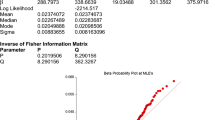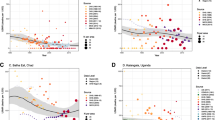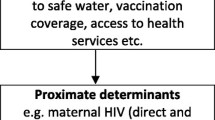Abstract
A method is presented for estimating the “underlying” infant mortality rates for areas with small populations, described and illustrated in a case study that estimates infant mortality rates for 66 of 89 local health areas in British Columbia where reported births were less than 649 in 2011, including 38 reporting zero infant deaths. The method generates non-zero infant mortality rates for all 66 districts. Although some judgment is needed with the method, it has sufficient transparency that estimates can be replicated. The results support the argument that the method can produce reasonable estimates of underlying infant mortality rates for small populations subject to high levels of stochastic variation.
Résumé
Une méthode est présentée pour estimer les taux de mortalité «sous-jacents» dans des zones à population réduite. Cette méthode est décrite et illustrée à l’aide d’une étude de la mortalité infantile au sein de 66 des 89 zones de santé de la Colombie-Britannique où les naissances déclarées étaient inférieures à 649 en 2011, et parmi lesquelles 38 zones ne signalaient aucun décès avant l’âge d’un an. La méthode génère des taux de mortalité infantile non nuls pour l'ensemble des 66 districts. Bien que la méthode nécessite un certain jugement, elle est suffisamment claire pour que les estimations puissent être répliquées. Les résultats corroborent l'argument selon lequel la méthode peut produire des estimations raisonnables des taux sous-jacents de mortalité infantile pour de petites populations soumises à de fortes variations stochastiques.



Similar content being viewed by others
Notes
Murray (1996) has argued that the infant mortality rate is flawed when it is used as an index of overall mortality (i.e., the mortality regime affecting a given population) and that Disability Adjusted life Expectancy (DALE) should be used in its place. However, it has been pointed out by Reidpath and Allotey (2003) that the infant mortality rate and the DALE are so highly correlated that it merely goes to reinforce the intuition that the causes of infant mortality are strongly related to those structural factors like economic development, general living conditions, social well-being, and environmental factors, and, and such, the infant mortality rate remains a useful and comparatively inexpensive indicator of population health. Guillot et al. (2013) also note that infant mortality is responsive to changes in annual mortality conditions because it involves a short lag between the timing of mortality exposures and the timing of corresponding births.
Although it uses a different context and terms, another example of the entire process can be found in Robinson (2015).
The third quartile was used as the point to distinguish between large populations and small populations because the distribution of populations across a given type of administrative area tends to be skewed. This effect is commonly known as the “rank-size rule” or “rank-size distribution” (Zipf 1949; Massey et al. 1980; Stephan and Stephan 1984; Swanson and Stephan 2004). When the births by Local Health Area were ranked in descending order and plotted, a distinct plateau is seen that starts approximately at the 74th percentile (approximately the third quartile) and continues approximately to the 11th percentile, whereupon the number again increases. The plateau suggested that those at or above this level were different in terms of size than those below this level. Other ways could be used to distinguish between large and small populations that may be useful. However, given that this paper represents an initial exploration of this method, it seems appropriate to examine other ways to distinguish large from small populations in subsequent research.
Note that as stated in the text, the validity test mimics the fact that for its 58 counties California reports IMRs only for 43 of them for the 2009–2011 period, leaving the remaining 15 counties without reported IMRs. As such, the validity test was set up as if there were 43 units for which IMRs were reported and 15 for which they were not. However, all of the data used in the validity test were generated from the synthetic population that is based on Model Life Table, level 23, as described in the text. The reporting structure as well as the actual data for California can be found through the Open Portal service provided by the California Health and Human Services Agency via a download of a CVS data set assembled by the California Department of Public Health. This data set can be accessed by going to https://data.chhs.ca.gov/dataset/infant-mortality-deaths-per-1000-live-births-lghc-indicator-01/resource/ae78da8f-1661-45f6-b2d0-1014857d16e3 and then clicking on the “download” tab, which downloads the file, “Infant Mortality, Deaths Per 1000 Live Births (LGHC Indicator 01) (CSV)” in CVS form. Once downloaded, it can be saved as an excel file. The data in this file include the infant mortality rates (identified as “rate” in the file) and the infant deaths (identified as “numerator” in the file) and live births (identified as “denominator” in the file) used to calculate the IMRs for all counties and other administrative areas, including the state as a whole. The data represent the period 2009–2011. A description of the methods, caveats, and so forth associated with this data set can be found on the ULR shown above.
In the validity test, different populations are simulated from a common beta-distribution, and the result is that the two sets of populations, large and small, are normally distributed around the intrinsic mean IMR of the “population.” The simulation shows that the adjusted IMRs of the small populations move closer the underlying IMR, which indicates that the method works when both the small and large populations represent samples taken from the same underlying population. If the small populations represent a sample from a different population than the sample of large population, then the adjustment may yield a “biased” estimate of the former’s underlying IMR. This shows the importance of having a reference set that conceptually represents a sample from the same underlying population as the small population sample. One way to visualize the unbiased and biased outcomes is to picture the case where the method yields: (1) an “unbiased” estimate, which is when the mean IMR of the large populations is between the underlying IMR and the mean IMR of the small populations, and (2) a “biased” estimate when the method does not move the mean IMR for the small population closer to its underlying IMR, which occurs where the mean IMR of the small population is between the underlying IMR and the mean IMR of the large populations.
Although Green and Armstrong (2015) discuss simple vs. complex methods in terms of forecasting, their discussion applies here in that the beta-binomial approach falls into the simple methodological category rather than the complex category. Adapting their discussion to methods in general, the work of Green and Armstrong (2015) suggests that while there is no evidence that shows complexity improves accuracy, complexity remains popular among (1) researchers, because they are rewarded for publishing in highly ranked journals, which favor complexity; (2) methodologists, because complex methods can be used to provide information that support decision makers’ plans; and (3) clients, who may be reassured by incomprehensibility. We believe that the argument by Green and Armstrong (2015) can be applied to Bayesian methods, which represents the “complex” alternative to the “simple” beta-binomial approach. We prefer the beta-binomial approach, however, not only because of the argument presented by Green and Armstrong, but also because the application of a Bayesian approach can be difficult, effortful, opaque, and even counter-intuitive (Goodwin 2015).
References
Baker, J., Alcantara, A., & Ruan, X. (2011). A stochastic version of the Brass PF ratio adjustment of age-specific fertility schedules. PLoS ONE, 6(8), e23222. https://doi.org/10.1371/journal.pone.0023222.
Brass, W., Coale, A., Demeny, P., Heisel, D., Lorimer, F., Romaniuk, A., & Van de Walle, E. (1968). The demography of tropical Africa. Princeton: Princeton University Press.
British Columbia Vital Statistics Agency. (2012). Selected vital statistics and health status indicators: one hundredth and fortieth annual report 2011. Victoria: British Columbia Ministry of Health.
Chen, A., Oster, E., & Williams, H. (2016). Why is infant mortality higher in the United States than in Europe? American Journal of Economic Policy, 8(2), 89–124.
Gardiner, C. (1983). Handbook of stochastic methods for physics, chemistry, and the natural sciences. New York: Springer.
Goodwin, P. (2015). When simple alternatives to Bayes formula work well: reducing the cognitive load when updating probability forecasts. Journal of Business Research, 68, 1686–1691.
Graham, C., & Talay, D. (2013). Stochastic simulation and Monte Carlo methods. New York: Springer.
Green, K., & Armstrong, J. S. (2015). Simple versus complex forecasting: the evidence. Journal of Business Research, 68, 1678–1685.
Guillot, M., Lim, S., Torgasheva, L., & Denisenko, M. (2013). Infant mortality in Kyrgyzstan before and after the break-up of the Soviet Union. Population Studies, 67(3), 335–352.
Hummer, R. (2005). Income, race, and infant mortality: comment on Stockwell et al. Population Research and Policy Review, 24, 405–409.
Infant Mortality Review Committee. (2016). Infant mortality report: a three year review of infant deaths in the Island Health Region. Victoria, BC: Island Health.
Karlin, S., & Taylor, S. (2001). A first course in stochastic processes (2nd ed.). San Diego: Academic Press.
Kinge, J., & Kornstad, T.. (2014). Assimilation effects on infant mortality among immigrants to Norway: does maternal source country matter? A Demographic Research 31. Available online at https://www.demographic-research.org/volumes/vol31/26/default.htm.
Kitagawa, E., & Hauser, P. (1973). Differential mortality in the United States: a study in socioeconomic epidemiology. Cambridge: Harvard University Press.
Kleinman, J. (1996). Underreporting of infant deaths: then and now. American Journal of Public Health, 76(4), 365–366.
Link, W., & Hahn, D. (1996). Empirical Bayes estimation of proportions with application to cowbird parasitism rates. Ecology, 77(8), 2528–2537.
Link, B., & Phelan, J.. (1995). Social conditions as fundamental causes of disease. Journal of Health and Social Behavior (extra issue): 80–94.
Massey, D., Tedrow, L., & Stephan, G. E. (1980). Regional population density and county size: a note on the problem of tautology in size-density relationships. Geographical Analysis, 12, 184–188.
Misra, D., Grason, H., Liao, M., Strobino, D., McDonnell, K., & Allston, A. (2004). The nationwide evaluation of fetal and infant mortality reviewed (FIMR) programs: development and implementation of recommendations and conduct of essential maternal and child health services by FIMR programs. Maternal Child Health Journal, 8(4), 217–229.
Moultrie, T., Dorrington, R., Hill, A., Hill, K., Rob Dorrington, I., Allan, H., Timæus, I., & Zaba, B. (2013). Tools for demographic estimation. Paris: International Union for the Scientific Study of Population.
Murray, C. (1996). Rethinking DALYs. In C. Murray & A. Lopez (Eds.), The global burden of disease: a comprehensive assessment of mortality and disability from diseases, injuries, and risk factors in 1990 and projected to 2020 (pp. 1–98). Cambridge: Harvard School of Public Health.
Ram, B., Singh, A., & Yadav, A. (2016). The persistent caste divide in India’s infant mortality: a study of Dalits (ex-untouchables), Adivasis (indigenous peoples), other backward classes, and forward classes. Canadian Studies in Population, 43(3-4), 249–263.
Reeske, A., & Razum, O. (2011). Maternal and child health—from conception to first birthday. In B. Recehl, P. Mladovsky, W. Devillé, B. Rijks, R. Petrova-Benedict, & M. Mckee (Eds.), Migration and health in the European Union (pp. 139–153). Berkshire: Open University Press.
Reidpath, D., & Allotey, P. (2003). Infant mortality rate as an indicator of population health. Journal of Epidemiology and Community Health, 57, 344–346.
Robinson, D. (2015). Understanding empirical Bayes estimation (using baseball statistics). http://varianceexplained.org/r/empirical_bayes_baseball.
Siegel, J., & Swanson, D. (2004). The methods and materials of demography (2nd ed.). Los Angeles: Academic/Elsevier Press.
Statistics Canada (2017). Infant and perinatal mortality, by sex, three-year average, Canada, provinces, territories, health regions and peer groups. (Cansim, Table 102-4319, available at http://www5.statcan.gc.ca/cansim/a26?lang=eng&retrLang=eng&id=1024319&&pattern=&stByVal=1&p1=1&p2=-1&tabMode=dataTable&csid=.
Stephan, G. E., & Stephan, K. (1984). Population redistribution and changes in the size density slope. Demography, 21(1), 35–40.
Stockwell, E., Bedard, M., Swanson, D. A., & Wicks, J. (1987). Public policy and the socioeconomic mortality differential in infancy. Population Research and Policy Review, 6(Fall), 105–121.
Stockwell, E., Goza, F., & Balisteri, K. (2005). Infant mortality and socioeconomic status: new bottle, same old wine. Population Research and Policy Review, 24, 387–339.
Swanson, D., & Stephan, G. E. (2004). Glossary and demography timeline. In J. Siegel & D. Swanson (Eds.), The methods and materials of demography, condensed edition, revised (pp. 751–786). Los Angeles: Academic/Elsevier Press.
Swanson, D., & Tayman, J. (2012). Subnational opulation estimates. Dordrecht: Springer.
United Nations. (1967). Manual IV, methods of estimating basic demographic measures from incomplete data. New York: United Nations.
US National Center for Health Statistics (2018). Linked Birth/Infant Death Records 2007–2015, as compiled from data provided by the 57 vital statistics jurisdictions through the Vital Statistics Cooperative Program, on CDC WONDER On-line Database. http://wonder.cdc.gov/lbd-current.html.
US National Center for Health Statistics (n.d.). Data Use Restrictions. https://wonder.cdc.gov/datause.html.
VanEenwyk, J., & Macdonald, S. (2012). Guidelines for working with small numbers. Olympia: Washington Department of Health, Environmental Public Health Division Available at https://www.doh.wa.gov/Portals/1/Documents/1500/SmallNumbers.pdf.
Vaupel, J., & Missov, T. (2014). Unobserved population heterogeneity: a review of formal relationships. Demographic Research, 31(22), 659–686.
Voss, P. R., Palit, C., Kale, B., & Krebs, H. (1995). Censal ratio methods. In N. W. Rives, W. J. Serow, A. S. Lee, H. F. Goldsmith, & P. R. Voss (Eds.), Basic methods for preparing small-area estimates (pp. 70–89). Madison: Applied Population Laboratory, University of Wisconsin.
Zipf, G. (1949). Human behavior and the principle of least effort. Cambridge: Addison-Wesley.
Acknowledgments
The author thanks the following for suggestions and advice: Dr. Augustine Kposowa (Professor, University of California Riverside), Dr. Richard Verdugo (retired, National Education), Dr. Jack Baker (Chief Analyst, HealthFitness Corporation), and Dr. Tom Burch (Affiliated Professor, University of Victoria). In addition, comments by two anonymous reviewers were very useful.
Author information
Authors and Affiliations
Corresponding author
Rights and permissions
About this article
Cite this article
Swanson, D.A. Estimating the Underlying Infant Mortality Rates for Small Populations, Even Those Reporting Zero Infant Deaths: a Case Study of 66 Local Health Areas in British Columbia. Can. Stud. Popul. 46, 173–187 (2019). https://doi.org/10.1007/s42650-019-00014-7
Received:
Accepted:
Published:
Issue Date:
DOI: https://doi.org/10.1007/s42650-019-00014-7




